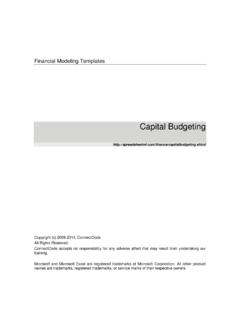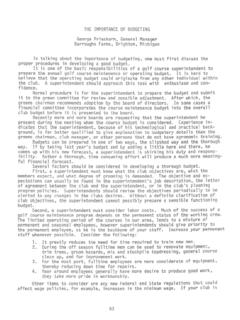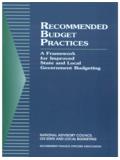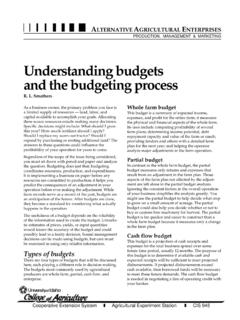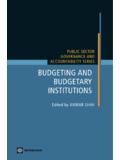Transcription of The role of Budget Classifications in budgetary …
1 The role of Budget Classificationsin budgetary reforms OECD 5th Senior Budget Officials MeetingSt. Petersburg25-26 June 2009 Brian Olden IMF PFM Regional AdvisorSouth East Europe Why are Budget Classifications Systems Important? One of the fundamental building blocks of a sound Budget management system. Provides a normative framework for both policy decision-making and accountability. Classifying expenditures and revenues correctly is important for: policy formulation and performance analysis. allocating resources efficiently among sectors. ensuring compliance with the budgetary resources approved by the legislature. day-to-day administration of the Principles of Budget classification Systems1 The principle of comprehensiveness Requires that the Budget cover all government entities and institutions undertaking government operations, present a consolidated and complete view of these operations.
2 The principle of unity Requires that the Budget include all revenues and expenditures of all government entities undertaking government operations. This principle is important to ensure that the Budget is effective in constraining total and sectoral government expenditure, and in promoting greater efficiency in the allocation of resources. The principle of internal consistency Requires consistency between different components of the Budget In particular, current expenditure needed for the operations and maintenance of past investment projects be fully reflected in the Budget . Moreover, this principle implies that there should not be a dual Budget system in which responsibilities among ministries, institutions, or entities in preparing and executing current and capital (or development) spending are Source Public Financial Management Technical Guidance Note, IMF Fiscal Affairs Department Budget classification Daviina Jacobs, Jean-Luc H lis, and Dominique BouleyWhat should a Budget classification System Contain?
3 A sound system of Budget classification should, at a minimum, comprise a classification of: revenues into various categories. an administrative, economic, and functional Classifications of expenditures. However, increasingly focus is on classification system capable of linking funding to results rather than inputs. Increase transparency and accountability and increase information to enable better management of the public finances. In particular, program Classifications The programmatic classification of expenditure that is, the grouping of expenditure by common objective for budgeting purposes is a basic information tool used by most contemporary performance budgeting systems.
4 The program classification of expenditure is intended to introduce clarity about the objectives being pursued through public expenditure, the government activities aimed at achieving these, and about the amounts being spent on them. The classification of expenditure by objectives is not intended only for budgetary planning and reporting purposes. The aim is, rather, that it should serve to promote budgetary decision-making which more closely aligns government activities with political priorities, and contributes to better public sector performance. Source: Public Sector Performance Budgeting: Linking Funding to Results : IMF 2007, Marc Robinson Ed.
5 Functional/program classification In many cases programs can be linked directly to functions. Functional classification does not need to be identical to COFOG. But must be able to produce GFS/ESA reports. Links to sub-functions are more difficult. May need separate bridging classification Combine organizational and program classification ? Reasonable for top level. Programs usually related to only one ministry (more discussion on this later). What about lower levels? Over time, lower organizational structure should converge towards program structure. Difficult to impose at beginning rapid organizational change not easy in large bureaucratic structures.
6 Should lead to activity-driven output and outcome definitions. In transition economies organizational and program Classifications should usually be separate, at least below top classification still needed with programmatic structure Program Classifications should be capable of being broken down into relevant inputs for analysis purposes. Separate from program classification . Programs should include both current and capital elements. economic classification identifies different categories of inputs. Must be able to link economic inputs to programs results. Source of Fund classification Tempting to combine with programs. Some donor-financed activities coincide with programs (for instance debt relief).
7 Special financing for priority programs. Will simplify structure. However may undermine ability to fully integrate all sources of funding in Budget . May result in being unable to track funds channeled to different programs. Need separate within the same overall classification system Organization Function Program Economic Funding Ministry Agency Department Division Function Sub-function Program Sub-program Activity Type Head Item Detail Type Organization Project Combine function/programOtion 1 Option 2 Function Program Function/program Function Sub-function (Bridge table) Program Sub-program Activity Function Sub-function Program Sub-program Activity Organization/programOtion 1 Option 2?
8 Very difficult in practice. Organization Program Organization/program Ministry Agency Department Division Program Sub-program Activity Ministry Agency/Program Department/Sub-program Division/Activity UK Program structureDirectorate Main programs Targets Appropriations are mainly done by Department (Ministry) Children, young people and families Schools Lifelong learning Higher education Every child matters Sure start, Extended schools Youth Safeguarding Primary, 11 19 11 19 Success for all Adult skills Higher education 1 and 2 3 and 12 5 4, 6 and 9 7, 8, 10 and 11 13 14 Program Classifications and the link to outcomes The programmatic classification of expenditure should be combined with good information about the results delivered by programs(performance measures, evaluations etc).
9 Only then can it assist decision-makers to make more informed judgments on competing policy objectives. Program classification of expenditure is also widely seen as contributing to improved productive efficiency. relaxation of line-item controls gives managers greater flexibility in the choice of the mix of inputs used to produce outputs, which can potentially result in substantially improved productivity. Increased freedom to function without externally imposed line item controls, however, carries with it an obligation by these managers to track accurately the costs associated with pursuing various outcomes and requirements for successful implementation of programmatic classification Budget to be prepared in programmatic format by Spending Units.
10 For multi annual budgeting purposes forward estimates to be compiled on a program by program basis. Legislative body should be prepared to appropriate expenditures by program rather than line item. Estonia is an example where a de-linkage between budgetary planning documents (programmatic) and Budget appropriations (organizational and economic based) has led to proposals to change to program based Budget documentation should be in programmatic format. Statement of program objective Description of program activities. and outputs. Indicators to be used to measure program performance (outputs/outcomes). Possibly program performance targets (if feasible).











